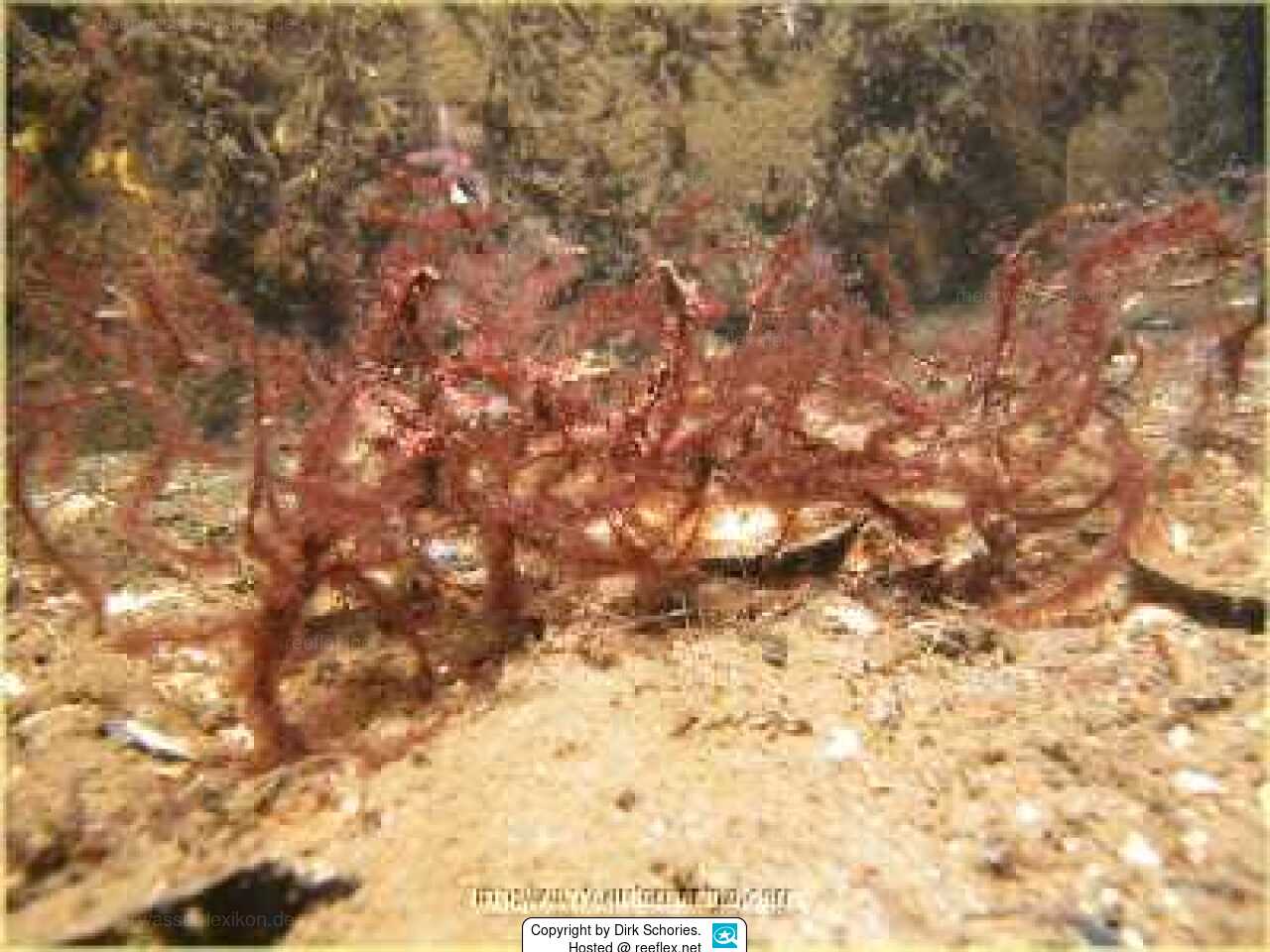Info
Dasya pedicellata is a heat-loving and introduced species that originally comes from the Pacific Ocean and is therefore considered a neozoan.
It was mainly introduced as stowaways, with fishing/aquaculture equipment, on ships, and as fouling on ships.
Several special characteristics helped the red algae to conquer new marine areas: it is euryhaline and can adapt to salinity levels of 5–30‰, allowing it to thrive in brackish water zones such as the Baltic Sea.
Dasya pedicellata is also extremely resistant to pollution, even to hydrogen sulfide soils and oil, and thrives in ports.
Sometimes the large plants can cover the sediment floor almost like a carpet, which probably makes it difficult to access oxygenated water.
In addition, the red algae can cope well with temperatures of up to 30° Celsius, making it almost an “all-rounder” among marine algae!
However, the species does not thrive on strongly wavy beaches, but copes well with fast-flowing waters such as cooling water outlets and tidal currents.
Dasya pedicellata is an annual red algae that is multi-branched and forms narrow, stiff, and protruding branches, often attaching itself to mussel and oyster shells.
Its color ranges from carmine to brownish red with a distinct main axis and a number of side shoots.
The stem and branches are covered with short red hairs, which give the algae a feathery appearance.
Older specimens have fewer hairs.
As already mentioned, Dasya pedicellata is a heat-loving species that originated in the Pacific, so how do significantly cooler waters such as those found in the Nordic countries fit into its distribution range?
The explanation lies in the reproduction (sexual and asexual) and the seasonal appearance of the species, which is only “visible” in colder waters from spring to fall.
Gametophytes and tetrasporophytes occur mainly in summer and are often fertile at temperatures above 15 °Celsius, surviving up to 30 °Celsius.
However, they can also survive the winter as young plants thanks to their resistant, starch-filled adhesive plates.
Dasya pedicellata is considered almost “cosmopolitan,” with only Arctic and Antarctic waters remaining uninhabited by the species to date.
Like all marine algae, Dasya pedicellata is an oxygen producer.
Synonyms:
Baillouviana pedicellata (C.Agardh) Kuntze, 1891 · unaccepted (synonym)
Dasya baillouviana (S.G.Gmelin) Montagne, 1841 · unaccepted
Dasya elegans (G.Martens) C.Agardh, 1828 · unaccepted (synonym)
Dasya elegans var. ramosissima Schiffner, 1938 · unaccepted
Dasya mazei (P.L.Crouan & H.M.Crouan) G.Murray, 1888 · unaccepted
Eupogodon mazei P.L.Crouan & H.M.Crouan, 1865 · unaccepted
Fucus baillouviana S.G.Gmelin, 1768 · unaccepted
Rhodonema elegans G.Martens, 1824 · unaccepted
Sphaerococcus pedicellatus C.Agardh, 1822 · unaccepted (synonym)
It was mainly introduced as stowaways, with fishing/aquaculture equipment, on ships, and as fouling on ships.
Several special characteristics helped the red algae to conquer new marine areas: it is euryhaline and can adapt to salinity levels of 5–30‰, allowing it to thrive in brackish water zones such as the Baltic Sea.
Dasya pedicellata is also extremely resistant to pollution, even to hydrogen sulfide soils and oil, and thrives in ports.
Sometimes the large plants can cover the sediment floor almost like a carpet, which probably makes it difficult to access oxygenated water.
In addition, the red algae can cope well with temperatures of up to 30° Celsius, making it almost an “all-rounder” among marine algae!
However, the species does not thrive on strongly wavy beaches, but copes well with fast-flowing waters such as cooling water outlets and tidal currents.
Dasya pedicellata is an annual red algae that is multi-branched and forms narrow, stiff, and protruding branches, often attaching itself to mussel and oyster shells.
Its color ranges from carmine to brownish red with a distinct main axis and a number of side shoots.
The stem and branches are covered with short red hairs, which give the algae a feathery appearance.
Older specimens have fewer hairs.
As already mentioned, Dasya pedicellata is a heat-loving species that originated in the Pacific, so how do significantly cooler waters such as those found in the Nordic countries fit into its distribution range?
The explanation lies in the reproduction (sexual and asexual) and the seasonal appearance of the species, which is only “visible” in colder waters from spring to fall.
Gametophytes and tetrasporophytes occur mainly in summer and are often fertile at temperatures above 15 °Celsius, surviving up to 30 °Celsius.
However, they can also survive the winter as young plants thanks to their resistant, starch-filled adhesive plates.
Dasya pedicellata is considered almost “cosmopolitan,” with only Arctic and Antarctic waters remaining uninhabited by the species to date.
Like all marine algae, Dasya pedicellata is an oxygen producer.
Synonyms:
Baillouviana pedicellata (C.Agardh) Kuntze, 1891 · unaccepted (synonym)
Dasya baillouviana (S.G.Gmelin) Montagne, 1841 · unaccepted
Dasya elegans (G.Martens) C.Agardh, 1828 · unaccepted (synonym)
Dasya elegans var. ramosissima Schiffner, 1938 · unaccepted
Dasya mazei (P.L.Crouan & H.M.Crouan) G.Murray, 1888 · unaccepted
Eupogodon mazei P.L.Crouan & H.M.Crouan, 1865 · unaccepted
Fucus baillouviana S.G.Gmelin, 1768 · unaccepted
Rhodonema elegans G.Martens, 1824 · unaccepted
Sphaerococcus pedicellatus C.Agardh, 1822 · unaccepted (synonym)







 Dr. Dirk Schories, Deutschland
Dr. Dirk Schories, Deutschland


